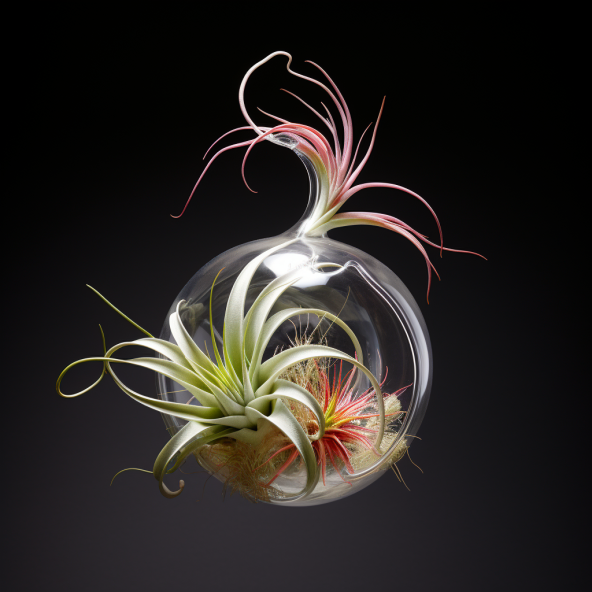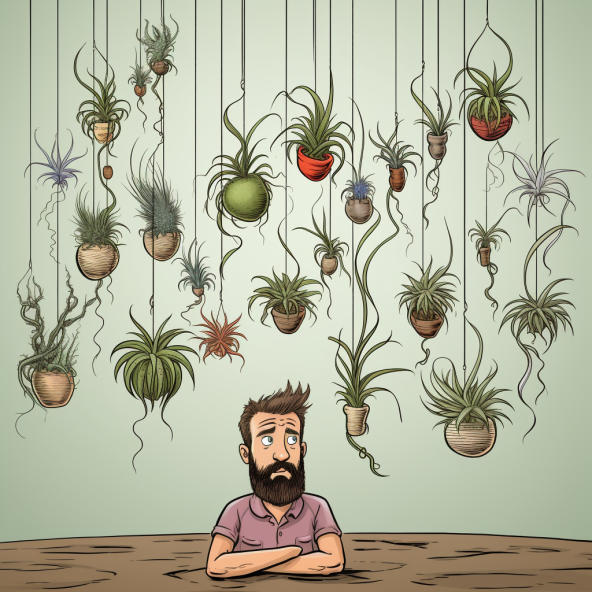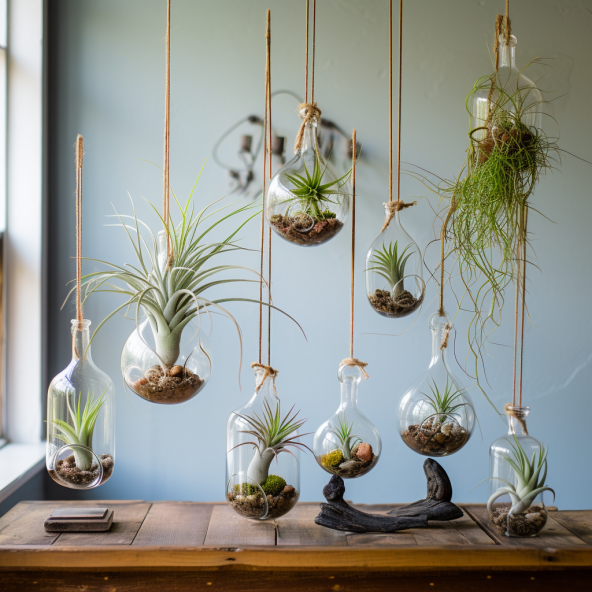
Air plants, known scientifically as Tillandsia, have swept into the hearts of plant enthusiasts with their unique charm and low-maintenance nature. These soilless wonders are not only fascinating botanical specimens but also versatile decor elements that can enhance any living space. In this comprehensive guide, we’ll explore the ins and outs of air plant care, ensuring that even beginners can cultivate a thriving air plant collection.
Introduction to Air Plants
Welcome to the enchanting world of air plants, the soil-free marvels that are captivating gardeners and home decorators alike. These remarkable plants, known as Tillandsia, belong to the bromeliad family and have evolved to thrive in a range of environments, from the dense forests of South America to the arid deserts of the southern United States. Their unique ability to absorb water and nutrients through their leaves allows them to grow without the need for soil, making them one of the most versatile and easy-to-care-for plants in the botanical kingdom.
In this ultimate guide, we’ll delve into everything you need to know to grow and care for your own air plants, ensuring that even those with the busiest of schedules or the smallest of living spaces can enjoy the lush beauty and interesting textures that these plants bring. Whether you’re an experienced gardener or a complete novice, air plants offer a delightful way to bring a touch of nature into your home without the commitment required by more traditional potted plants.
Air plants come in an impressive variety of shapes, sizes, and colors, with some species boasting vibrant blooms that can last several weeks. Their striking appearance makes them perfect for creative displays, from hanging glass terrariums to rustic driftwood mounts. And since they don’t need soil, you can place them almost anywhere—on a desk, by the bed, or even in the bathroom, where the humidity is just right for these moisture-loving beauties.
As we embark on this journey through the world of air plants, prepare to be inspired by the simplicity and elegance of these peculiar plants. Not only will you learn the essential aspects of air plant care, including proper lighting, watering, and air circulation, but you’ll also discover innovative ways to exhibit your tillandsias, turning them into living art within your home.
So let’s get started and breathe a fresh breath of air into your living space with the ultimate guide to growing and caring for air plants. Prepare to transform your home with these gravity-defying wonders and discover the joy of cultivating a thriving air plant collection.
Next, we will explore why air plants have become such a beloved addition to homes around the world and what makes them such an attractive choice for indoor gardening.

Why Air Plants?
Air plants have soared in popularity for a multitude of reasons, making them a staple in the modern home. Their distinctive nature of thriving without soil sets them apart from other houseplants, bringing a minimalist and almost otherworldly aesthetic to any space. But the appeal of air plants extends beyond their unconventional growth habits and striking appearance.
One of the most compelling reasons to invite air plants into your home is their incredible adaptability. These plants have a unique resilience that allows them to survive in a wide range of environments, which is why they can be found in the diverse climates of the jungle, mountains, and deserts. This adaptability translates well to the home setting, where they can tolerate various light levels and temperatures, making them an excellent choice for those spaces where other plants might struggle.
Moreover, air plants are the epitome of low-maintenance gardening. Without the need for soil, you won’t have to worry about overwatering, repotting, or the mess that soil can bring into your living spaces. This ease of care is particularly appealing to those who love the idea of houseplants but lack the time or desire to tend to more demanding species.
In addition to their carefree nature, air plants are also known for their air-purifying abilities. Like many houseplants, they take in carbon dioxide and release oxygen, but they also have the capacity to remove certain pollutants from the air, contributing to a healthier indoor environment for you and your family.
The versatility of air plants in decor is unmatched. With their gravity-defying form, they can be showcased in a myriad of ways: mounted on walls, suspended in air, nestled in shells, or simply placed on a shelf. This opens up endless possibilities for creativity and personal expression in home decorating.
Finally, air plants offer an opportunity for anyone to develop a green thumb. Their forgiving nature makes them an ideal choice for novice gardeners, providing a confidence-boosting experience in plant care. For seasoned gardeners, the vast variety of Tillandsia species presents a delightful challenge to collect and nurture these exotic beauties.
As we delve into the world of air plants, you’ll discover that these are not just plants; they are a lifestyle choice that brings beauty, ease, and a sense of calm into your home. With the next section, we’ll guide you through the process of selecting the perfect air plants for your environment, ensuring a match that is both beautiful and beneficial to your lifestyle.

Selecting Your Air Plants
The Essentials of Air Plant Care
Embarking on the journey of air plant ownership begins with selecting the right Tillandsia species for your space and lifestyle. With over 650 species, plus numerous hybrids, the diversity within the Tillandsia genus is astounding, offering a wide array of textures, forms, and colors to choose from. When picking out your air plants, consider a few key factors to ensure that they not only survive but also thrive in your care.
Light Preferences: Air plants generally prefer bright, indirect sunlight. Varieties with thinner, softer leaves tend to do better in lower light conditions, while those with thicker, silver-frosted leaves are often more suited to brighter, more direct light. Consider the lighting conditions of the areas where you intend to display your air plants and choose species that will be happy in your home’s unique environment.
Size and Space: The size of air plants can vary dramatically, from tiny, inch-wide specimens to large, show-stopping pieces that span several feet. Assess the space where you want to place your air plants. Do you have a small desk that needs a petite touch of green, or a large room that could handle a more dramatic display? Make sure to select sizes that complement your available space.
Humidity and Air Flow: Air plants absorb water and nutrients through their leaves, so they appreciate good air circulation and some humidity. If you live in a drier climate or have home heating that reduces indoor humidity, look for hardier species that can tolerate less moisture. Conversely, if your home is more humid, like a bathroom with a shower, you can opt for species that thrive in those conditions.
Blooming and Color: Many air plant enthusiasts are drawn to the vibrant blooms and colorful leaves that some Tillandsia species offer. If flowers are important to you, seek out species known for their spectacular blooms or seasonal color changes. Keep in mind that blooms are often a once-in-a-lifetime event for each air plant, but the bright colors and unique shapes of the flowers can make the wait worthwhile.
Growth Habits: Some air plants grow in a rosette pattern and may eventually produce “pups,” or offsets, which you can separate to form new plants. If you’re interested in propagation and expanding your collection, these types can be particularly rewarding.
When selecting your air plants, don’t hesitate to ask for advice at your local nursery or from experienced air plant growers. They can provide valuable insights into the care requirements of different species and help guide your choices. Additionally, purchasing from reputable sources ensures that your air plants are healthy and sustainably sourced.
Now that you have a better understanding of how to select your air plants, you’re ready to learn about the essential care they need to flourish. In the following sections, we’ll cover all the basics, from lighting and watering to the all-important air circulation, to make your air plant care journey a resounding success.
Interested in what else you can grow? Check out our other guides!
Caring for air plants involves understanding their basic needs, which are quite different from those of typical soil-grown plants. By providing the right balance of light, water, and air, you can ensure your air plants remain healthy and vibrant. Let’s break down these essentials to give you a clear picture of how to nurture your Tillandsia collection.
Lighting Conditions
Light is a crucial factor in the well-being of air plants. In their natural habitat, air plants often grow under the canopy of trees, receiving dappled sunlight. To replicate these conditions, place your air plants in a location where they will get plenty of bright, indirect light. A north or east-facing window is ideal as it provides the gentle morning sunlight that air plants love without the harsh afternoon rays that can scorch their leaves.
If natural light is limited in your home, don’t worry—air plants are adaptable and can also thrive under artificial lighting. Fluorescent lighting, like that found in office environments, can be a good alternative, just ensure that the plants are close enough to the light source to benefit from it. Aim for about 12 hours of light per day to mimic the natural cycle of daylight.
Watering Routine
Watering air plants may seem counterintuitive since they don’t grow in soil, but it’s a vital aspect of their care. The best method for hydrating your air plants is to give them a good soak. Submerge the plants in room temperature water for 20 to 30 minutes once a week. This soaking mimics the rainfall of their native habitats and allows the plants to fully rehydrate. After their bath, shake off any excess water and place them upside down to ensure water doesn’t collect at the base of the leaves, which could cause rot.
In drier climates or during hot seasons, you may need to mist your air plants between soakings to provide extra humidity. Be cautious not to overwater, as stagnant moisture can lead to decay. Always allow your air plants to dry thoroughly in a well-ventilated area before returning them to their display spot.
Air Circulation
Air plants need good air flow to thrive. In nature, they are accustomed to the breezy conditions found in tree branches or rocky outcrops. At home, ensure that your air plants are in a space where the air can circulate freely around them. Avoid enclosed terrariums or tight spaces where air cannot move; instead, opt for open terrariums, wireframes, or simply placing them on an open shelf.
Air circulation not only aids in drying the plants after watering but also helps to provide the carbon dioxide necessary for photosynthesis. A gentle fan or an airy room can provide the circulation your air plants need to flourish.
With these essential care tips in mind, your air plants will be well-equipped to grow and even bloom. In the next section, we’ll tap into your creative side as we explore the endless possibilities for displaying these versatile plants in your home. Get ready to transform your space with living sculptures that reflect your personal style and enhance your décor.
Creative Display Ideas

The true joy of owning air plants lies not just in their easy care, but in the boundless creativity they inspire for display and decoration. Air plants are like living art, offering a blank canvas for your imagination to run wild. Here are some inventive ways to showcase your Tillandsia collection that will surely turn heads and spark conversations.
Hanging Glass Terrariums
Glass terrariums provide a stunning way to exhibit air plants. Suspended from the ceiling or perched on a shelf, these clear vessels offer a 360-degree view of the plant’s delicate structure. You can fill them with accents like sand, pebbles, or moss to create miniature landscapes, or keep them minimalist with just a single air plant floating inside. The transparency of glass terrariums allows for ample light, and their open design encourages airflow, making them an ideal habitat for your Tillandsia.
Driftwood and Natural Elements
For a more organic and rustic appeal, consider mounting your air plants on pieces of driftwood, cork bark, or even seashells. The natural textures of these materials complement the ethereal quality of the air plants, creating a harmonious blend of earth and air. Use safe, water-soluble glue to attach the plants, or simply nestle them into crevices and hollows in the wood. These natural mounts can be placed on tabletops, hung on walls, or suspended from the ceiling, adding a touch of woodland charm to your home.
Wireframes and Geometric Holders
If your style leans more towards modern and architectural, wireframes and geometric holders serve as excellent platforms for your air plants. These structures can be found in a variety of shapes—spheres, diamonds, cubes—and can be painted to match your décor. Air plants can be woven into the wire or rested within the geometric shapes, creating an eye-catching display that feels both contemporary and organic.
Living Wreaths and Wall Art
Air plants can be used to craft living wreaths or even framed as wall art. By attaching air plants to a wreath form or a canvas, you can create a living sculpture that evolves as the plants grow and bloom. This approach offers a unique twist on traditional wall hangings and brings a fresh, botanical vibe to any room.
Magnetic Displays
For those with limited space, magnetic air plant holders can be a clever solution. These small, powerful magnets can be attached to the base of an air plant and then placed on any magnetic surface, such as a refrigerator or metal lamp. This way, your air plants can float in the air, defying gravity and adding a pop of green to unexpected places.
When creating your air plant displays, consider the care requirements of your plants. Ensure that your chosen display method still allows for easy watering and provides sufficient light and air flow. With a little creativity, your air plants can become a living part of your home décor, reflecting your personal taste and bringing nature’s beauty into your everyday life.
In our next section, we’ll address some common issues you might encounter with air plants, and provide you with the know-how to tackle these challenges head-on, keeping your Tillandsia collection healthy and thriving.
Troubleshooting Common Air Plant Issues
Even with their reputation as hardy and low-maintenance, air plants can sometimes face challenges. Recognizing and addressing common problems early can help ensure your air plants remain healthy and continue to enchant. Here are some typical issues that might arise and the solutions to keep your Tillandsia flourishing.
Brown Tips or Dry Leaves
Brown tips on the leaves of your air plants can indicate under-watering or low humidity. If you notice this, consider increasing the frequency of your waterings or adding a light misting to your care routine between soaks. Ensure that after each watering, the plants have enough air circulation to dry properly, as trapped moisture can lead to rot.
Wilting or Dehydrated Plants
Wilting or curling leaves often suggest dehydration. This can be remedied by soaking your air plants for a longer period, especially during dry or hot seasons. Submerging the plants for up to an hour can help revive them. Consistent watering is key to preventing dehydration, but always allow the plants to dry thoroughly before placing them back in their display.
Overwatering and Rot
Overwatering is a common issue, especially for enthusiastic new air plant owners. If the leaves start to become soft or you notice a black or rotten base, your air plants might be getting too much water, or not enough air flow to dry out between waterings. Reduce your watering schedule, and make sure your plants are in a well-ventilated area. If rot has set in, remove the affected parts of the plant to prevent it from spreading.
Pests
While air plants are relatively resistant to pests, they can occasionally be troubled by scale or mealybugs. These pests appear as small bumps or cottony masses on the plants and can be treated by dabbing the affected areas with a cotton swab dipped in alcohol. Regular inspection and prompt treatment can keep these pests at bay.
Failure to Bloom
Many air plant enthusiasts look forward to the vibrant blooms that some species offer. If your air plants are not blooming, it could be due to a lack of adequate light or nutrients. Providing a brighter environment or fertilizing with a bromeliad-friendly fertilizer can encourage blooming. Remember, most air plants bloom only once in their lifetime, so patience is key.
Clumping and Pups
As part of their natural life cycle, air plants will produce offsets, or “pups,” which grow at the base of the mother plant. If the clump becomes too dense, it can be divided to allow more space for individual plants to grow. Gently pull the pups apart when they are about one-third the size of the parent plant, giving them their own opportunity to thrive.
By being attentive to these common issues and knowing how to address them, you can maintain a healthy and thriving air plant collection. Now that we’ve equipped you with the knowledge to troubleshoot potential problems, let’s explore how integrating air plants into your daily life can offer more than just aesthetic pleasure but also a rewarding connection with nature.
In the next section, we will delve into how caring for air plants can become a therapeutic hobby and a meaningful part of your routine.

Cat-Friendly Gardening: Creating a Safe Haven for Your Feline Friends
Table of Contents Introduction Hey there, fellow feline enthusiasts! 🐾 Welcome to a space where your garden becomes not just a patch of green but

From Lilies to Sago Palms: Protect Your Cat from These 10 Toxic Plants
Table of Contents Introduction: Keeping Your Furry Friend Safe from Toxic Plants Hey there, fellow cat lovers! We all know our feline companions can be

Cat Nutrition 101: Decoding Labels & Essential Nutrients A-Z!
Table of Contents Introduction As a cat owner, you want nothing but the best for your furry feline friend. And that includes providing them with
